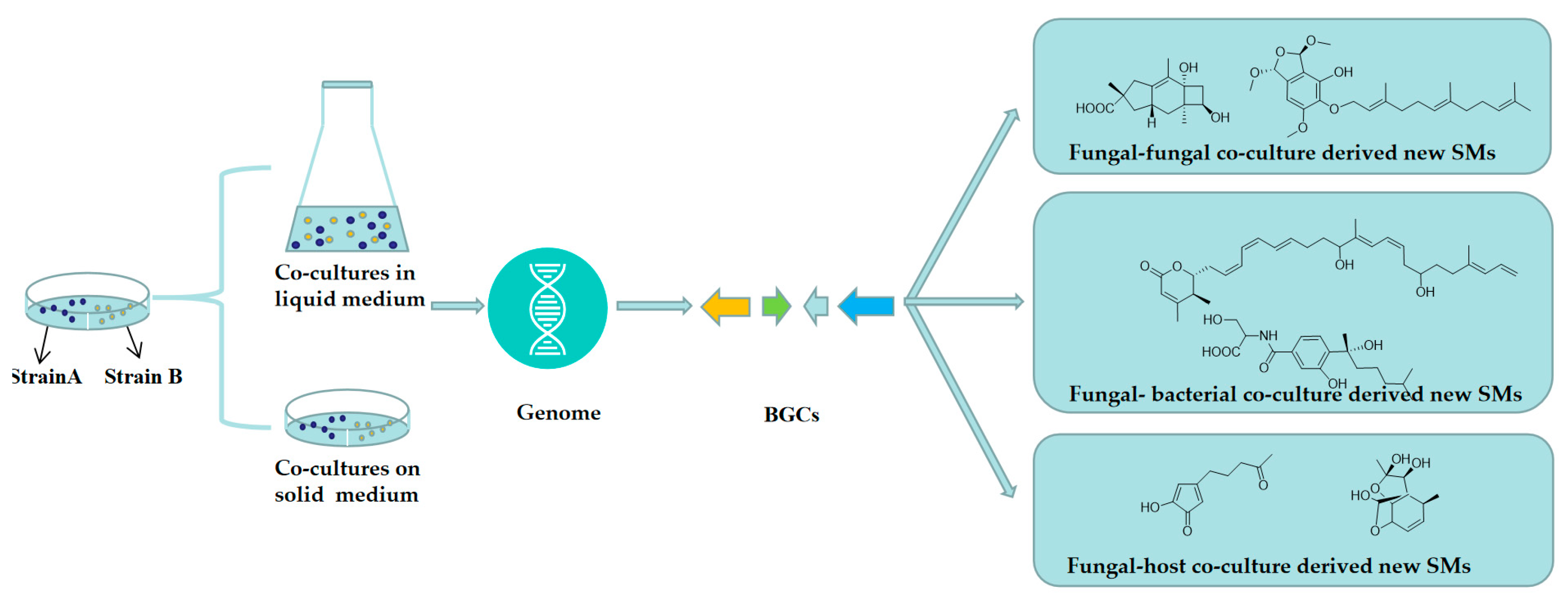2023年发表文章
1. Zhikun Yang#, Xue Yang#, Yasheng Li, Yue Cai, Yanlei Yu, Wenya Zhuang, Xuanrong Sun, Qingyong Li, Xiaoze Bao, Xinyi Ye, Jinmiao Tian, Bin Wei, Jianwei Chen, Qihao Wu, Huawei Zhang, Xiaozhou Mou*, Hong Wang*. Design, synthesis and biological evaluation of novel phenylfuran-bisamide derivatives as P-glycoprotein inhibitors against multidrug resistance in MCF-7/ADR cell. European Journal of Medicinal Chemistry. 2023. 248:115092. (https://doi.org/10.1016/j.ejmech.2023.115092) IF:7.088
Abstract

The co-administration of anticancer drugs and P-glycoprotein (P-gp) inhibitors was a treatment strategy to surmount multidrug resistance (MDR) in anticancer chemotherapy. In this study, novel phenylfuran-bisamide derivatives were designed as P-gp inhibitors based on target-based drug design, and 31 novel compounds were synthesized and screened on MCF-7/ADR cells. The result of bioassay revealed that compound y12d exhibited low cytotoxicity and promising MDR reversal activity (IC50 = 0.0320 μM, reversal fold = 1163.0), 3.64-fold better than third-generation P-gp inhibitor tariquidar (IC50 = 0.1165 μM, reversal fold = 319.3). The results of Western blot and rhodamine 123 accumulation verified that compound y12d exhibited excellent MDR reversal activity by inhibiting the efflux function of P-gp but not expression. Furthermore, molecular docking showed that compound y12d bound to target P-gp by forming the double H-bond interactions with residue Gln 725. These results suggest that compound y12d might be a potential MDR reveal agent acting as a P-gp inhibitor in clinical therapeutics, and provide insight into design strategy and skeleton optimization for the development of P-gp inhibitors.
2. Ying Song#, Dong-Ze Lu#, Hong-Gang Wang, Zhen-Yi Zhou, Xian Luo, Man-Jing Ma, Song-Ze Ke, Hong Wang, Yan-Lei Yu, Bin Wei*. Metagenomic insights into the anti-obesity effect of a polysaccharide from Saccharina japonica. Foods. 2023, 12(3): 665.(https://doi.org/10.3390/foods12030665)IF: 5.561
Abstract
Saccharina japonica polysaccharides exhibit great potential to be developed as anti-obesity and prebiotic health products, but the underlying mechanism has not been adequately addressed. In this study, we investigated the potential mechanism of a S. japonica polysaccharide fraction (SjC) in preventing high-fat-diet (HFD)-induced obesity in mice using 16S rRNA gene and shotgun metagenomic sequencing analysis. SjC was characterized as a 756 kDa sulfated polysaccharide and 16 weeks of SjC supplementation significantly alleviated HFD-induced obesity, insulin resistance, and glucose metabolism disorders. The 16S rRNA and metagenomic sequencing analysis demonstrated that SjC supplementation prevented gut microbiota dysbiosis mainly by regulating the relative abundance of Desulfovibrio and Akkermansia. Metagenomic functional profiling demonstrated that SjC treatment predominantly suppressed the amino acid metabolism of gut microbiota. Linking of 16S rRNA genes with metagenome-assembled genomes indicated that SjC enriched at least 22 gut bacterial species with fucoidan-degrading potential including Desulfovibrio and Akkermansia, which showed significant correlations with bodyweight. In conclusion, our results suggest that SjC exhibits a promising potential as an anti-obesity health product and the interaction between SjC and fucoidan-degrading bacteria may be associated with its anti-obesity effect.
3. Bin Wei, Ao-Qi Du, Ti-Ti Ying, Gang-Ao Hu, Zhen-Yi Zhou, Wen-Chao Yu, Jing He, Yan-Lei Yu, Hong Wang*, and Xue-Wei Xu*. Secondary metabolic potential of Kutzneria. Journal of Natural Products. 2023. 86(4): 1120.(https://doi.org/10.1021/acs.jnatprod.3c00007)IF: 4.803
Abstract

Kutzneria is a rare genus of Actinobacteria that harbors a variety of secondary metabolite gene clusters and produces several interesting types of bioactive secondary metabolites. Recent efforts have partially elucidated the biosynthetic pathways of some of these bioactive natural products, suggesting the diversity and specificity of secondary metabolism within this genus. Here, we summarized the chemical structures, biosynthetic pathways, and key metabolic enzymes of the secondary metabolites isolated from Kutzneria strains. In-depth comparative genomic analysis of all six available high-quality Kutzneria genomes revealed that the majority (77%) of the biosynthetic gene cluster families of Kutzneria were untapped and identified homologues of key metabolic enzymes in the putative gene clusters, including cytochrome P450s, halogenases, and flavin-dependent N-hydroxylases. The present study suggests that Kutzneria exhibits great potential to synthesize novel secondary metabolites, encodes a variety of valuable metabolic enzymes, and also provides valuable information for the targeted discovery and biosynthesis of novel natural products from Kutzneria.
4. Yuqi Guo, Youmin Ying, Qihao Wu, Bin Wei, Jianwei Chen*, Hong Wang*. β -Cyclopiazonic acid binds iron demonstrating siderophore-like activity and promotes growth in Pseudomonas aeruginosa*. Journal of Oceanology and Limnology. 2023, 41, 1159-1167. (https://doi.org/10.1007/s00343-022-2007-3)IF: 1.6(中国海洋湖沼学会主办、中国科学院海洋研究所承办的英文期刊)
Abstract
This chemical study reports a novel siderophore-like compound, β-cyclopiazonic acid (1, β-CPA) extracted from marine fungus Aspergillus flavus. The chemical structure of β-CPA was elucidated by a combination of extensive spectroscopic analyses and TDDFT-ECD calculations. The iron-binding ability and CAS assays demonstrate that β-CPA is a novel siderophore that features a different chemical structure from those of traditional siderophores. The β-CPA has no obvious influence on the growth of bacterium Pseudomonas aeruginosa PAO1. However, its iron chelator could promote the growth of P. aeruginosa PAO1, suggesting that P. aeruginosa employed siderophores to sequester iron, which is vital for their survival. The study provides the physiochemical evaluation of β-CPA, an unusual skeleton-structure siderophore, which for the first time, was proven to have the ability to bind iron and affect P. aeruginosa growth. This new discovery of siderophore provides an opportunity for developing novel anti-P. aeruginosa drugs.
5. Zhikun Yang#, Yue Cai#, Xue Yang, Yasheng Li, Qihao Wu, Yanlei Yu, Zhen Chen, Bin Wei, Jin-miao Tian, Xiaoze Bao, Xinyi Ye, Jianwei Chen, Huawei Zhang, Xiaozhou Mou, Xuanrong Sun*, Hong Wang*. Novel Benzo Five-membered Heterocycle Derivatives as P-glycoprotein Inhibitors: Design, Synthesis, Molecular Docking, and Anti-multidrug Resistance Activity. Journal of Medicinal Chemistry. 2023. 66: 5550-5566. (https://doi.org/10.1021/acs.jmedchem.2c01999) IF: 8.039
Abstract

A proposed strategy to overcome multidrug resistance (MDR) of anticancer drugs in chemotherapy is to disable the efflux function of P-glycoprotein (P-gp). In this study, based on ring-merging and fragment-growing strategies, 105 novel benzo five-membered heterocycle derivatives were designed, synthesized, and screened. Exploration of the structure-activity relationship (SAR) led to the identification of d7 with low cytotoxicity and promising reversal activity to doxorubicin in MCF-7/ADR cells. Furthermore, the mechanism studies revealed that the reversal activity of d7 stemmed from the inhibition of P-gp efflux. Molecular docking further clarified the observed trends in SAR with d7 displaying potent affinity to P-gp. Additionally, coadministration of d7 with doxorubicin achieved stronger antitumor activity in a xenograft model than doxorubicin alone. These results suggest that d7 is a potential MDR reveal agent acting as a P-gp inhibitor and provides guidelines for the future development of new P-gp inhibitors.
6. Jianwei Chen*, Yuqi Guo, Qihao Wu, Wei Wang, Jiangwei Pan, Mingchong Chen, Hong Jiang, Qunjian Yin, Gaiyun Zhang, Bin Wei, Huawei Zhang, Hong Wang*. Discovery of new siderophores from a marine Streptomycetes sp. via combined metabolomics and analysis of iron-chelating activity. Journal of Agricultural and Food Chemistry. 2023, 71(17): 6584-6593. (https://doi.org/10.1021/acs.jafc.3c00234) IF: 6.1
Abstract

The marine-derived Streptomyces sp. FIMYZ-003 strain was found to produce novel siderophores with yields negatively correlated with the iron concentration in the medium. Mass spectrometry (MS)-based metabolomics coupled with metallophore assays identified two novel α-hydroxycarboxylate-type siderophores, fradiamines C and D (3 and 4), together with two related known siderophores, fradiamines A and B (1 and 2). Their chemical structures were elucidated by nuclear magnetic resonance (NMR) and MS experiments. The annotation of a putative fra biosynthetic gene cluster enabled us to propose the biosynthetic pathway of fradiamines A–D. Furthermore, the solution-phase iron-binding activity of fradiamines was evaluated using metabolomics, confirming them as general iron scavengers. Fradiamines A–D exhibited Fe(III) binding activity equivalent to that of deferoxamine B mesylate. Growth analysis of pathogenic microbes demonstrated that fradiamine C promoted the growth of Escherichia coli and Staphylococcus aureus, but fradiamines A, B, and D did not. The results indicate that fradiamine C may serve as a novel iron carrier applicable to antibiotic delivery strategies to treat and prevent foodborne pathogens.
7. Zhikun Yang#, Yue Cai#, Shen Mao#, Qihao Wu, Mengdi Zhu, Xiaoji Cao, Bin Wei, Jinmiao Tian, Xiaoze Bao, Xinyi Ye, Jianwei Chen, Sijia Wang, Yanlei Yu, Huawei Zhang, Xuanrong Sun, Zining Cui, Yasheng Li, Hong Wang. Discovery of 2,5-disubstituted furan derivatives featuring a benzamide motif for overcoming P-glycoprotein mediated multidrug resistance in MCF-7/ADR cell. European Journal of Medicinal Chemistry. 2023. 257:115462. (DOI: 10.1016/j.ejmech.2023.70: 115462,https://doi.org/10.1016/j.ejmech.2023.115462) IF:7.088
Abstract

P-glycoprotein (P-gp) is one of the drug efflux transporters that triggers multidrug resistance (MDR) in cells. Herein, by utilizing the strategies of active skeleton splicing and structural optimization on the lead compound 5 m, a total of 50 novel 2,5-disubstituted furan derivatives were designed, synthesized, and screened for P-gp inhibitory activity. The structure-activity relationship analysis enabled the identification of an important pharmacophore N-phenylbenzamide, which resulted in the discovery of a promising drug lead compound Ⅲ-8. Ⅲ-8 possesses broad-spectrum reversal activity and low toxicity in MCF-7/ADR cells. Western blot and Rh123 accumulation assay demonstrated that Ⅲ-8 displayed the reversal activity by inhibiting P-gp efflux. Molecular docking analysis indicated a potent affinity of Ⅲ-8 to P-gp by forming H-bond interactions with residues Asn 721 and Met 986. Ⅲ-8 was determined to be a highly effective and safe P-gp inhibitor in an MCF-7/ADR xenograft mouse model.
8. Bin Wei#, Gang-Ao Hu#, Zhen-Yi Zhou, Wen-Chao Yu, Ao-Qi Du, Cai-Ling Yang, Yan-Lei Yu, Jian-Wei Chen, Hua-Wei Zhang, Qi-Hao Wu, Qi Xuan*, Xue-Wei Xu*, and Hong Wang*. Global analysis of the biosynthetic chemical space of marine prokaryotes. Microbiome. 2023. 11: 144. (https://microbiomejournal.biomedcentral.com/articles/10.1186/s40168-023-01573-3) IF:16.837
Abstract

Background: Marine prokaryotes are a rich source of novel bioactive secondary metabolites for drug discovery. Recent genome mining studies have revealed their great potential to bio-synthesize novel secondary metabolites. However, the exact biosynthetic chemical space encoded by the marine prokaryotes has yet to be systematically evaluated.
Results: We first investigated the secondary metabolic potential of marine prokaryotes by analyzing the diversity and novelty of the biosynthetic gene clusters (BGCs) in 7541 prokaryotic genomes from cultivated and single cells, along with 26,363 newly assembled medium-to-high-quality genomes from marine environmental samples. To quantitatively evaluate the unexplored biosynthetic chemical space of marine prokaryotes, the clustering thresholds for constructing the biosynthetic gene cluster and molecular networks were optimized to reach a similar level of chemical similarity between the gene cluster family (GCF)-encoded metabolites and molecular family (MF) scaffolds using the MIBiG database. The global genome mining analysis demonstrated that the predicted 70,011 BGCs were organized into 24,536 mostly new (99.5%) GCFs, while the reported marine prokaryotic natural products were only classified into 778 MFs at the optimized clustering thresholds. The number of MF scaffolds is only 3.2% of the number of GCF-encoded scaffolds, suggesting that at least 96.8% of the secondary metabolic potential in marine prokaryotes is untapped. The unexplored biosynthetic chemical space of marine prokaryotes was illustrated by the 88 potential novel antimicrobial peptides encoded by ribosomally synthesized and post-translationally modified peptide BGCs. Furthermore, a sea-water-derived Aquimarina strain was selected to illustrate the diverse biosynthetic chemical space through untargeted metabolomics and genomics approaches, which identified the potential biosynthetic pathways of a group of novel polyketides and two known compounds (didemnilactone B and macrolactin A 15-ketone).
Conclusions: The present bioinformatics and cheminformatics analyses highlight the promising potential to explore the biosynthetic chemical diversity of marine prokaryotes and provide valuable knowledge for the targeted discovery and biosynthesis of novel marine prokaryotic natural products.
9. Jiamin Wu#, Fei Hu#, Guishun Bai, Yang Yang, Damien Bonne, Jean Rodriguez, Congyong Yue, Hong Wang*, and Xiaoze Bao*. Basicity-Controlled [3+2] Cyclization of 3-Hydroxyquinolinones and β-Chlorinated Nitrostyrenes. European Journal of Organic Chemistry. 2023, 26(22): e202300218. (Very Important Paper, DOI: 10.1002/ejoc.202300218, https://chemistry-europe.onlinelibrary.wiley.com/doi/10.1002/ejoc.202300218) IF: 2.8.
Abstract

The construction of novel skeletons through the recombination of natural products ring systems is attractive. Herein, a basicity-controlled synthesis of (dihydro)furo[2,3-c]quinolin-4(5H)-one derivatives through (3+2) cyclization between 3-hydroxyquinolin-2-ones and β-chlorinated nitrostyrenes was developed. In addition, preliminary study gave the chiral dihydrofuro[2,3-c]quinolin-4(5H)-one derivatives with up to 83 % ee.
10. Xingyue Wang, Guishun Bai, Ruoqi Liu, Xiaoli Zhu, Xinyi Ye, Tao Zhang, Kui Zhang, Damien Bonne*, Jean Rodriguez, Hong Wang*, and Xiaoze Bao*. Enantioselective Nucleophilic Vinylic Substitution (SNV) toward 3-Alkenyl-bisoxindoles Facilitated by C6′ Steric Bulk of Cinchona Alkaloid. Organic Letters. 2023, 25(32): 5941–5945. (DOI: 10.1021/acs.orglett.3c01964, https://pubs.acs.org/doi/10.1021/acs.orglett.3c01964) IF: 5.2
Abstract

A C6′ bulky substituted quinine-catalyzed SNV reaction between 3-substituted oxindole and (E)-3-(nitromethylene)-oxindole was developed. This enantioselective C(sp3)–C(sp2) coupling furnished bisoxindole scaffolds featuring a vinyl-substituted all-carbon quaternary stereocenter with high stereoselectivities. In addition, the gram-scale synthesis and synthetic post-transformations were conducted to demonstrate the potential synthetic usefulness.
11. Jianwei Chen*, Xiaoya Yu, Xingyue Lu, Wei Wang, Jiangwei Pan, Qunjian Yin, Bin Wei, Huawei Zhang, Hong Wang*. Biosynthesis and gene regulation of rhamnolipid congeners. Current Microbiology. 2023, 80, 302. (https://doi.org/10.1007/s00284-023-03405-x) IF: 2.6
Abstract

Rhamnolipid congeners have been widely used in agriculture and biomedicine as potent surfactants. They have recently attracted attention due to their diverse and versatile biological functions, which include an important bacterial virulence factor that makes them attractive targets for research into biosynthetic pathways and gene regulation. The intricate gene expression and regulation network controlling their biosynthesis remain to be completely understood. This article summarizes current knowledge about the biosynthesis pathways and regulatory mechanisms of rhamnolipid congeners, that meet the pharmacological needs of human health and agriculture.
12. Shao Fangjun#, Ma Fandong#, Yuanan Li#, Jiang Wenjie, Wei Zhongzhe, Zhong Xing, Wang Hong, Wang Ligeng, Wang Jianguo*. Ru Supported on p-phthalic acid-Mn Derived from a Mn Metal–Organic Framework for Thermo- and Electrocatalytic Synthesis of Ethylene-D4 Glycol. ChemSusChem. 2023, 16, e202202395. ( https://doi.org/10.1002/cssc.202202395) IF: 8.4
Abstract
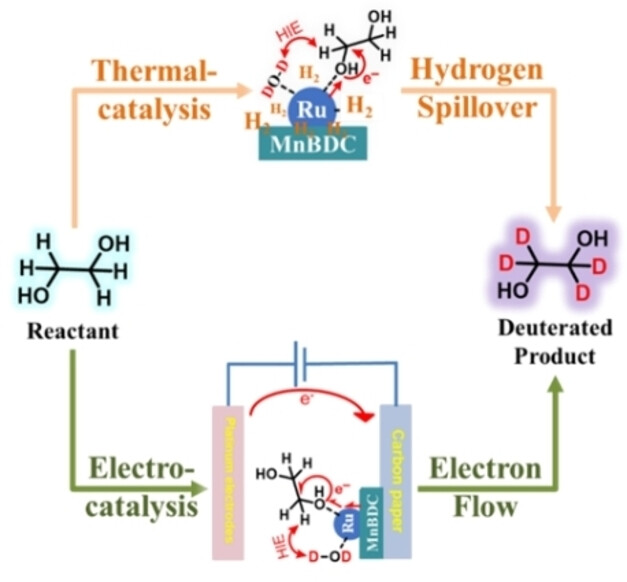
Deuterium-labeled polyols are one of the most extensive applied chemicals in biochemistry and biophysics. However, the deuteriation still is insufficient, exhibiting a low deuterated ratio and indistinct reaction mechanism. Herein, Ru supported on MnBCD (MnBDC, derived from Mn p-phthalic acid metal-organic framework) as nanocatalyst with an agglomerated sheet-type structure; this allows the possibility of achieving both thermo- and electrocatalytic hydrogen isotope exchange (HIE) reaction. Furthermore, XPS characterization confirmed that the specific structural changes in the electron density of Ru outer layers were modulated through the impregnation and reduction processes. According to the change of outer electronic structure, hydrogen spillover and electron-rich flow promote the reaction of the catalyst in thermo- and electrocatalytic systems, respectively. In addition, the results indicate that a high deuterated ratio of 97 % can be obtained, hence the catalytic technology has enormous potential for the synthesis of a broad variety of deuterium-labeled compounds.
13. Jiang Wenjie, Shao Fangjun*, Cheng Jiaxu, Ma Fandong, Wei Zhongzhe, Zhong Xing, Wang Hong, Wang Jianguo*. Calcium Aluminate Induced Pt(0)-Pt(δ+) Coupling Boost Catalyzed H-D Exchange Reaction of Arenes with Deuterium Oxide. Asian Journal of organic chemistry. 2023, 12, e202200662. (https://doi.org/10.1002/ajoc.202200662) IF: 2.7
Abstract
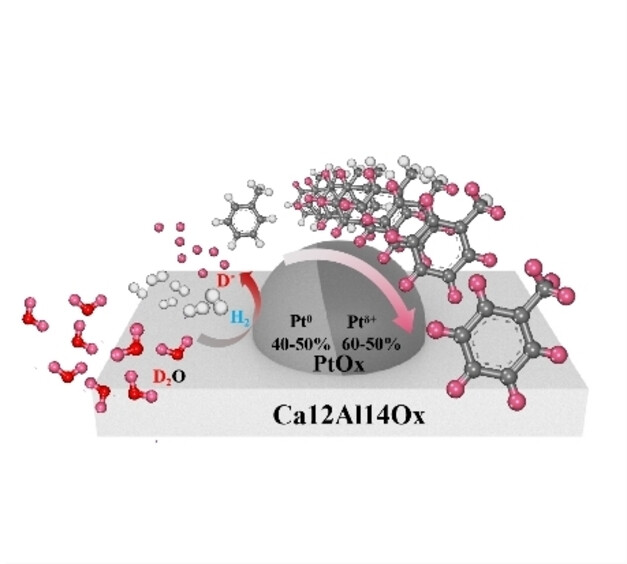
Deuterium(D)-labeled aromatics play an essential part in the Yield of fine chemicals. However, deuteration reactions are particularly dependent on the specific chemical environment of the metal to finish the oxidative addition and reductive elimination. Herein, a complex valence Pt/Ca12Al14Ox catalyst was successfully synthesized for the deuteration of toluene using inexpensive D2O. It exhibited high deuteration efficiency, achieving 96% deuteration in just 4 hours, 14% higher than the most commonly Pt/C catalyst. The catalyst can also be reactivated and recycled up to 16 times. Multiple characterization techniques were used to demonstrate the interaction between Pt and Ca12Al14Ox generates the co-existence of Pt(δ+) and Pt(0). The synergy between Pt(δ+) and Pt(0) can promote the completion of oxidation and elimination reactions. Thus, the complex valence of Pt improves the processes required for H−D exchange and boosts the reaction rate and stability of the hydrogen isotope exchange system.
14. Shao Fangjun*, Cheng Jiaxu, Song Xin, Wei Zhongzhe, Zhong Xing, Yao Zihao, Wang Hong, Sun Xiangdong, Li Aiyun, Wang Jianguo*. Effects of manganese on the catalytic performance of CuCo catalysts for direct conversion of CO/CO2 to higher alcohols. Dalton Transactions. 2023, 52, 461-468.(https://doi.org/10.1039/D2DT03445J) IF: 4.000
Abstract
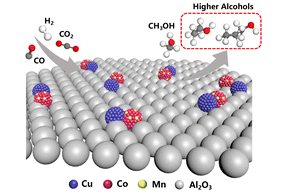
The catalytic conversion of CO or CO/CO2 mixtures to higher alcohols (HAs) using hydrogenation reactions remains challenging in C1 chemistry and also one of the most promising reactions for the utilization of non-petroleum resources. Here, the experiment and characterization tests of CuCoMn/Al2O3 show that copper is much more dispersed on γ-Al2O3 than cobalt, and the interaction between cobalt and Mn metals is stronger. And, mixed cobalt–manganese oxides are formed in the calcined catalyst, promoting the formation of higher alcohols. Under the optimum conditions, the catalyst demonstrated a total alcohol selectivity of 44.6%, and the fraction of higher alcohols reached up to 85.3% among the total alcohol products, which is superior to the classical modified CuCo-based catalysts. And in the gas mixture reaction with a CO : CO2 ratio of 8 : 2, the conversion rate of the catalyst to CO and CO2 reached 34.8% and 27.3%, respectively, and the selectivity (C1+ slate 1-alcohol) was 53.2%.
15. Shao Fangjun*, Wang Xiaojian, Zhao Zijiang, Wei Zhongzhe, Zhong Xing, Yao Zihao, Deng Shenwei, Wang Shibin, Wang Hong, Li Aiyuan, Wang Jianguo*. Ru Cluster-Decorated Cu Nanoparticles Enhanced Selectivity to Imine from One-Pot Cascade Transformations. Industrial & Engineering Chemistry Research. 2022, 61, 9, 3474–3482. (https://pubs.acs.org/doi/full/10.1021/acs.iecr.1c04357) IF: 4.20
Abstract

One-pot cascade transformations are environmentally friendly and are used to prepare complex organic molecules. However, chemselectivity is hard to control during the tandem reaction of imines. Herein, a Cu nanoparticle-decorated Ru cluster catalyst (Cu6Ru1.5/C-SiO2), with an average size of 2.1 nm, was designed and synthesized by impregnation and galvanic replacement. The synergistic effect of the Ru cluster and Cu nanoparticles caused Cu6Ru1.5/C-SiO2 to carry more Lewis acid active sites and constituted a unique catalyst surface. Then, the hydrogenation of nitrobenzene and reductive amination of benzaldehyde were effectively performed during a one-pot cascade transformation on the surface of the catalyst. Finally, N-benzylidene aniline (imine) was prepared smoothly by nitrobenzene and benzaldehyde with 96.3% selectivity in this catalytic system. This work provides a general and powerful strategy to optimize the catalytic performance, which can be scalable to other catalytic systems.
16. Qun-Jian Yin#, Ti-Ti Ying#, Zhen-Yi Zhou, Gang-Ao Hu, Cai-Ling Yang, Yi Hua, Hong Wang*, Bin Wei*. Species-specificity of the secondary biosynthetic potential in Bacillus. Frontiers in Microbiology. 2023, 14: 1271418. (https://www.frontiersin.org/articles/10.3389/fmicb.2023.1271418/full) IF: 5.20

Introduction: Although Bacillus species have produced a wide variety of structurally diverse and biologically active natural products, the secondary biosynthetic potential of Bacillus species is widely underestimated due to the limited number of biosynthetic gene clusters (BGCs) in this genus. The significant variation in the diversity and novelty of BGCs across different species within the Bacillus genus presents a major obstacle to the efficient discovery of novel natural products from Bacillus. Methods: In this study, the number of each class of BGCs in all 6,378 high-quality Bacillus genomes was predicted using antiSMASH, and the species-specificity of BGC distribution in Bacillus was investigated by Principal component analysis. Then the structural diversity and novelty of the predicted secondary metabolites in Bacillus species with specific BGC distributions were analyzed using molecular networking. Results: Our results revealed a certain degree of species-specificity in the distribution of BGCs in Bacillus, which was mainly contributed by siderophore, type III polyketide synthase (T3PKS), and transAT-PKS BGCs. B. wiedmannii, B. thuringiensis, and B. cereus are rich in RiPP-like and siderophore BGCs, but lack T3PKS BGCs, while B. amyloliquefaciens and B. velezensis are abundant in transAT-PKS BGCs. These Bacillus species collectively encode 77,541 BGCs, with NRPS and RiPPs being the two most dominant types, which are further categorized into 4,291 GCFs. Remarkably, approximately 54.5% of GCFs and 93.8% of the predicted metabolite scaffolds are found exclusively in a single Bacillus species. Notably, B. cereus, B. thuringiensis, and B. velezensis exhibit the highest potential for producing species-specific NRPS and PKS bioinformatic natural products. Taking two species-specific NRPS gene clusters as examples, the potential of Bacillus to synthesize novel species-specific natural products is illustrated. Conclusion: This study highlights the species-specificity of the secondary biosynthetic potential in Bacillus and provides valuable insights for the targeted discovery of novel natural products from this genus.
17. Wei Wang, Liting Gu, Jiahao Wang, Xubin Hu, Bin Wei, Huawei Zhang , Hong Wang* and Jianwei Chen*. Recent advances in polypeptide antibiotics derived from marine microorganisms. Marine Drugs. 2023, 21, 547. (https://doi.org/10.3390/md21100547) IF: 5.4
Abstract
In the post-antibiotic era, the rapid development of antibiotic resistance and the shortageof available antibiotics are triggering a new health-care crisis. The discovery of novel and potentantibiotics to extend the antibiotic pipeline is urgent. Small-molecule antimicrobial peptides havea wide variety of antimicrobial spectra and multiple innovative antimicrobial mechanisms due totheir rich structural diversity. Consequently, they have become a new research hotspot and areconsidered to be promising candidates for next-generation antibiotics. Therefore, we have compileda collection of small-molecule antimicrobial peptides derived from marine microorganisms fromthe last fifteen years to show the recent advances in this field. We categorize these compoundsinto three classes—cyclic oligopeptides, cyclic depsipeptides, and cyclic lipopeptides—according totheir structural features, and present their sources, structures, and antimicrobial spectrums, with adiscussion of the structure activity relationships and mechanisms of action of some compounds.
18. Bin Wei#, Xian Luo#, Zhen-Yi Zhou, Gang-Ao Hu, Lei Li*, Hou-Wen Lin*, Hong Wang*. Discovering the secondary metabolic potential of Saccharothrix. Biotechnology Advances. 2023, 70: 108295. (https://www.sciencedirect.com/science/article/pii/S0734975023002021?via%3Dihub) IF=16.0
Abstract

Graphical abstract
Rare actinomycetes are highly valued as potential sources of novel bioactive secondary metabolites. Among these rare actinomycetes, the genus Saccharothrix is particularly noteworthy due to its ability to produce a diverse range of bioactive secondary metabolites. With the continuous sequencing of bacterial genomes and the rapid development of bioinformatics technologies, our knowledge of the secondary metabolic potential of Saccharothrix can become more comprehensive, but this space has not been reviewed or explored. This review presents a detailed overview of the chemical structures and bioactivities of 138 Saccharothrix-derived secondary metabolites, which are classified into five distinct groups based on their biosynthetic pathways. Furthermore, we delve into experimentally characterized biosynthetic pathways of nine bioactive metabolites. By utilizing a combination of cheminformatic and bioinformatic approaches, we attempted to establish connections between the metabolite families and the biosynthetic gene cluster families encoded by Saccharothrix strains. Our analysis provides a comprehensive perspective on the secondary metabolites that can be linked to corresponding BGCs and highlights the underexplored biosynthetic potential of Saccharothrix. This review also provides guidance for the targeted discovery and biosynthesis of novel natural products from Saccharothrix.
19. Siqi Wang, Jiangwei Pan, Liting Gu, Wei Wang, Bin Wei, Huawei Zhang, Jianwei Chen*, Hong Wang*. Review of treatment options for a multi-drug resistant fungus: Candida auris, Medical Mycology. 2023, myad127. (https://doi.org/10.1093/mmy/myad127) IF: 2.9
Abstract
Candida auris is a widely distributed, highly lethal, multidrug-resistant fungal pathogen. It was first identified in 2009 when it was isolated from fluid drained from the external ear canal of a patient in Japan. Since then, it has caused infectious outbreaks in over 45 countries, with mortality rates approaching 60%. Drug resistance is common in this species, with a large proportion of isolates displaying fluconazole resistance and nearly half are resistant to two or more antifungal drugs. In this review, we describe the drug-resistance mechanism of C. auris, and potential small-molecule drugs for treating C. auris infection. Among these antifungal agents, rezafungin was approved by the FDA for the treatment of candidemia and invasive candidiasis on March 22, 2023. Ibrexafungerp and fosmanogepix have entered phase III clinical trials.
20.Jin-xin Zhu, Jin-Miao Tian, Yao-YaoChen, Xue-Jiao Hu, Xue Han, Wenchao Chen, Zhikun Yang, Xiaoze Bao, XinyiYe, Hua Chen, Fu-Min Zhang, Hong Wang* and Yong-QiangTu*. Enantioselective Synthesis of 2,3,3a,8a-Tetrahydrofuro[2,3‑b]benzofuranScaffolds Enabled by Cu(II)/SPDOCatalyzed [3+2] Cycloaddition of2,3-Dihydrofuran and Quinone Esters. Journal of OrganicChemistry. 2023, 88(20): 14670-14675. (https://doi.org/10.1021/acs.joc.3c01681) IF:3.6
Abstract

An asymmetric [3+2]cycloaddition of quinone esters with 2,3-dihydrofuran has been realizedvia a newly developed Cu(II)/SPDO complex. It provides straightforward accessto 2,3,3a,8atetrahydrofuro[2,3-b]benzofurans (TFB) with high enantioselectivity (upto 97.5:2.5 er) and diastereoselectivity (all >20:1 dr). The resultingadducts contain two adjacent stereocenters and a continuouslyfunctionalized benzene ring. Additionally, this transformation could beeasily performed on a gram scale, allowing for expedient synthesis ofnatural dihydroaflatoxin D2 and aflatoxin B2.
21. Sheng-Hui Zhu, Dan-Dan Yu, Ming-Zhi Su, Hui Luo, Li-Gong Yao, Feifei Gu, Lin-Fu Liang*, Hong Wang*, Yue-Wei Guo*. Oxygenated Cembrane Diterpenes from the South China Sea Soft Coral Sinularia tumulosa. Chemistry Biodiversity. 2023, 20, e202300589. (https://onlinelibrary.wiley.com/doi/10.1002/cbdv.202300589) IF: 2.9
Abstract

The chemical investigation of the rarely studied soft coral Sinularia tumulosa resulted in the discovery of five oxygenated cembrane diterpenes 1–5, including two new compounds situmulins A (1) and B (2). The structures of 1 and 2 were established through the extensive analyses of 1D and 2D NMR spectral data together with the comparisons with the known compounds. Furthermore, the absolute configuration of 1 was determined by the time-dependent density functional theory (TDDFT) ECD approach, while the relative configuration of 2 was assigned via the quantum mechanical-NMR (QM-NMR) calculations. It might be worth to point out it is the first time to disclose the presence of cembrane diterpenes in the title species. In the bioassays, compound 2 not only showed strong antibacterial activities against fish pathogenic bacteria Streptococcus parauberis FP KSP28 and Phoyobacterium damselae FP2244 with both minimum inhibitory concentration for 90% (MIC90) values of 25 μM, but also demonstrated substantial inhibitory efficacy against vancomycin-resistant Enterococcus faecium bacteria G1, G4, G7, G8 and G13 from several individuals, with MIC90 values of 25, 50, 100, 50 and 25 μM, respectively.
22. Song‑Wei Li, Dan‑Dan Yu, Ming‑Zhi Su, Li‑Gong Yao, Hong Wang*, Xueting Liu*, Yue‑Wei Guo*. Ocellatuspyrones A‒G, new antibacterial polypropionates from the Chinese mollusk Placobranchus ocellatus. Marine Life Science & Technology. 2023, 5:373-386. (https://doi.org/10.1007/s42995-023-00179-w) IF:5.70
Abstract
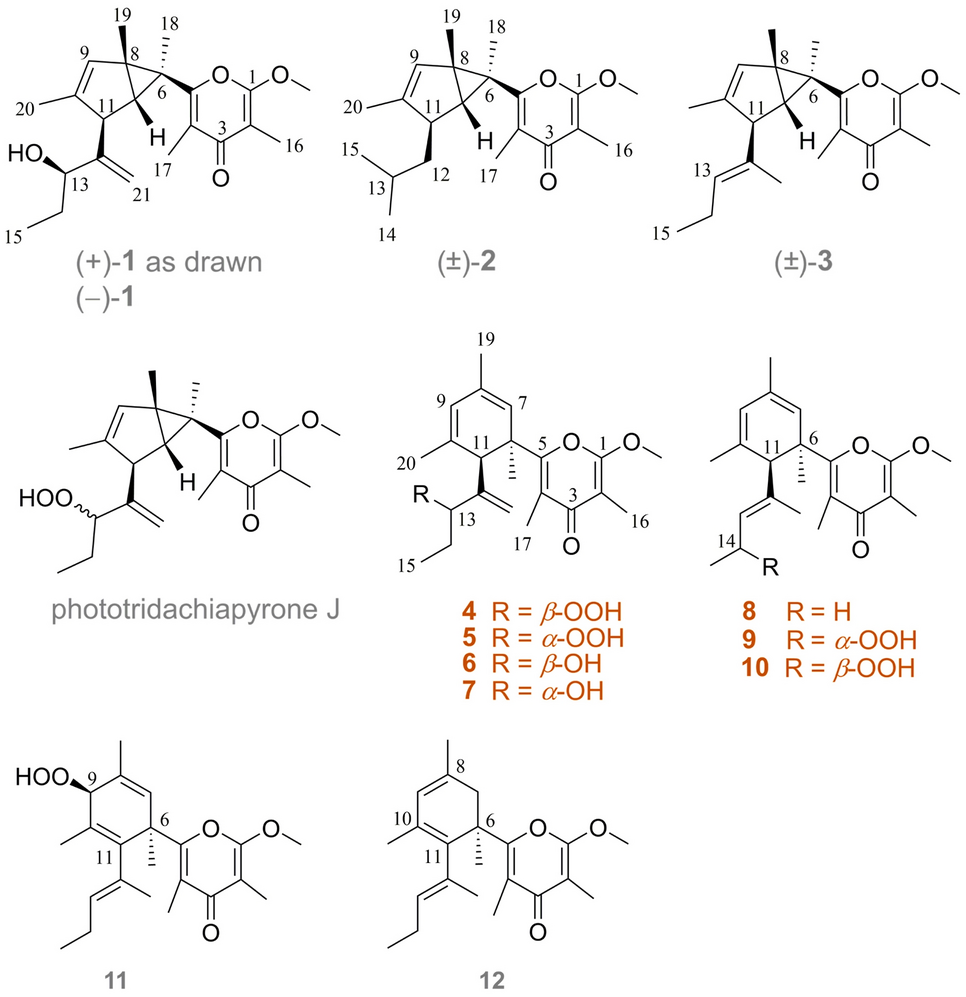
The structures of compounds 1−12
Marine invertebrates serve as rich sources of secondary metabolites with intriguing chemical diversities and a wide spectrum of biological activities. Particularly, marine shell-less sacoglossan mollusks have attracted much attentions due to the fact that mollusks apply complex metabolites as chemical defense agents against to their predators. With the purpose of discovering bioactive secondary metabolites to develop marine-derived medicines from the South China Sea, we have conducted a chemical study on the photosynthetic mollusk Placobranchus ocellatus. As a result, seven new γ-pyrone polypropionates, namely (±)-ocellatuspyrone A (1), (±)-ocellatuspyrone B (2), and ocellatuspyrones C−G (5, 9−12), along with fve known polypropionates, have been isolated and characterized from the South China Sea photosynthetic mollusk Placobranchus ocellatus. Extensive spectroscopic analysis, single crystal X-ray difraction analysis, modifed Mosher’s method, ECD comparison, CD exciton chirality method, TDDFT-ECD calculation, and chemical conversion were used to determine the structures and absolute confgurations of the new compounds and the stereochemistry of undefned known compounds 4, 6 and 7. All these isolated polypropionates were evaluated in bioassays for their biological activities, including antibacterial, neuroprotective efect, anti-infammatory, PTP1B inhibitory, and antiviral activities. Compounds 7, 8 and 11 were found for the frst time to show antibacterial activity against fsh pathogenic bacteria Streptococcus parauberis (the main pathogen causing fsh streptococcal infections and acute death) with MIC values of 35.8, 34.2, and 37.4 μg/mL, respectively, which might be potential novel antibacterial agents for the treatment of fsh infectious diseases.
23. Jia Jia, MingxinZheng, Chongwen Zhang, BingleiLi, Cai Lu, YuefanBai, Qian Tong, XudongHang, YixinGe, LipingZeng, MingZhao, FuhangSong, Huawei Zhang, LiangZhang, Kui Hong, Hongkai Bi*. Killing of Staphylococcus aureus persisters by a multitarget natural product chrysomycin A. Science Advances. 2023. 9, eadg599. (https://www.science.org/doi/epdf/10.1126/sciadv.adg5995) IF: 13.6
Abstract

Staphylococcusaureusposesaseverepublichealthproblemasoneofthevitalcausativeagentsofhealthcare and community-acquiredinfections.Thereisagloballyurgentneedfornewdrugswithanovelmodeofaction(MoA)tocombatS. aureusbiofilmsandpersistersthattolerateantibiotictreatment.Wedemonstratethataben-zonaphthopyranone glycoside,chrysomycinA (ChryA),is a rapid bactericidethat is highly active againstS.aureuspersisters, robustly eradicates biofilmsin vitro, and shows a sustainablekilling efficacy in vivo. ChryAwassuggestedtotargetmultiplecriticalcellularprocesses.Awiderangeofgeneticandbiochemicalapproachesshowed that ChryA directly binds to GlmU and DapD, involved in the biosyntheticpathways for the cell wallpeptidoglycanand lysine precursors,respectively, and inhibitsthe acetyltransferase activitiesby competitionwith their mutual substrate acetyl-CoA. Our studyprovidesan effective antimicrobial strategy combiningmul-tiple MoAs onto a single small moleculefor treatments ofS. aureuspersistent infections.
24. Yue Cai, Yuteng Chu, Yubei Gong, Yulu Hong, Fuhang Song, Hong Wang, Huawei Zhang*, Xuanrong Sun*. Enhanced Transdermal Peptide-Modified Flexible Liposomes for Efficient Percutaneous Delivery of Chrysomycin A to Treat Subcutaneous Melanoma and Intradermal MRSA Infection. Advanced Healthcare Materials. 2023, 12(26): e2300881. (https://doi.org/10.1002/adhm.202300881) IF: 10.0
Abstract

Superficial skin diseases, including skin infections and tumors, are common health care burdens. In this study, we explored the in vivo activity of chrysomycin A (CA) and further constructed a transdermal liposomal CA formulation for the simultaneous treatment of cutaneous melanoma and cutaneous methicillin-resistant Staphylococcus aureus (MRSA) infection. The prepared liposomes (TD-LP-CA) displayed a strong antitumor effect with an IC50 value of less than 0.1 µM in B16-F10 cells, suppressed the proliferation of MRSA with a minimum inhibitory concentration (MIC) of 1 µM, and eradicated established MRSA biofilms at 10 × MIC in vitro. More importantly, TD-LP-CA showed enhanced stratum corneum (SC) penetration, reaching more than 500 µm beneath the skin's surface due to modification with the TD peptide, and demonstrated excellent subcutaneous tumor penetration after skin application in vivo. TD-LP-CA displayed an excellent therapeutic effect against intradermal MRSA infection in mice after topical dermal administration, as well as a moderate inhibitory effect on subcutaneous melanoma with a 75% tumor inhibition rate. The liposomes prepared herein could be a promising carrier for transcutaneous CA transfer for the treatment of superficial diseases such as skin tumors and infections due to their ability to overcome the skin barrier. This article is protected by copyright. All rights reserved.
25. Dong-Ni Liu , Man Liu, Shan-Shan Zhang, Yu-Fu Shang, Wen-Fang Zhang, Fu-Hang Song, Hua-Wei Zhang, Guan-Hua Du*, Yue-Hua Wang*. Chrysomycin A Regulates Proliferation and Apoptosis of Neuroglioma Cells via the Akt/GSK-3β Signaling Pathway In Vivo and In Vitro. Marine Drugs. 2023, 21, 329. (https://doi.org/10.3390/md21060329) IF: 5.4
Abstract

Glioblastoma (GBM) is a major type of primary brain tumor without ideal prognosis and it is therefore necessary to develop a novel compound possessing therapeutic effects. Chrysomycin A (Chr-A) has been reported to inhibit the proliferation, migration and invasion of U251 and U87-MG cells through the Akt/GSK-3β signaling pathway, but the mechanism of Chr-A against glioblastoma in vivo and whether Chr-A modulates the apoptosis of neuroglioma cells is unclear. The present study aims to elucidate the potential of Chr-A against glioblastoma in vivo and how Chr-A modulates the apoptosis of neuroglioma cells. Briefly, the anti-glioblastoma activity was assessed in human glioma U87 xenografted hairless mice. Chr-A-related targets were identified via RNA-sequencing. Apoptotic ratio and caspase 3/7 activity of U251 and U87-MG cells were assayed via flow cytometry. Apoptosis-related proteins and possible molecular mechanisms were validated via Western blotting. The results showed that Chr-A treatment significantly inhibits glioblastoma progression in xenografted hairless mice, and enrichment analysis suggested that apoptosis, PI3K-Akt and Wnt signaling pathways were involved in the possible mechanisms. Chr-A increased the apoptotic ratio and the activity of caspase 3/7 in U251 and U87-MG cells. Western blotting revealed that Chr-A disturbed the balance between Bax and Bcl-2, activating a caspase cascade reaction and downregulating the expression of p-Akt and p-GSK-3β, suggesting that Chr-A may contribute to glioblastoma regression modulating in the Akt/GSK-3β signaling pathway to promote apoptosis of neuroglioma cells in vivo and in vitro. Therefore, Chr-A may hold therapeutic promise for glioblastoma.
26. Xuejun Lu, Manlai Zhang, Yixian Qiu, Xiuxiu Liu, Cancan Wang, Jianwei Chen, Huawei Zhang, Bin Wei, Yanlei Yu, Youmin Ying,*, Kui Hong*, Hong Wang*. α-Glucosidase Inhibitors from Two Mangrove-Derived Actinomycetes. Molecules. 2023, 28, 3822. (https://doi.org/10.3390/molecules28093822) IF: 4.927
Abstract

α-Glucosidase (AGS) inhibitors have been regarded as an ideal target for the management of type 2 diabetes mellitus (T2DM) since they can maintain an acceptable blood glucose level by delaying the digestion of carbohydrates and diminishing the absorption of monosaccharides. In the process of our endeavor in mining AGS inhibitors from natural sources, the culture broth of two mangrove-derived actinomycetes Streptomyces sp. WHUA03267 and Streptomyces sp. WHUA03072 exhibited an apparent inhibitory activity against AGS. A subsequent chemical investigation into the two extracts furnished 28 secondary metabolites that were identified by spectroscopic methods as two previously undescribed linear polyketides 1–2, four benzenoid ansamycins 3–6, fourteen cyclodipeptides 7–18, one prenylated indole derivative 19, two fusicoccane-type diterpenoids 20–21, two hydroxamate siderophore 22–23, and five others 24–28. Among all of the isolates, 11 and 24 were obtained from actinomycetes for the first time, while 20–21 had never been reported to occur in a marine-derived microorganism previously. In the in vitro AGS inhibitory assay, compounds 3, 8, 9, 11, 14, 16, and 17 exhibited potent to moderate activity with IC50 values ranging from 35.76 ± 0.40 to 164.5 ± 15.5 μM, as compared with acarbose (IC50 = 422.3 ± 8.4 μM). The AGS inhibitory activity of 3, 9, 14, 16, and 17 was reported for the first time. In particular, autolytimycin (3) represented the first ansamycin derivative reported to possess the AGS inhibitory activity. Kinetics analysis and molecular docking were performed to determine the inhibition types and binding modes of these inhibitors, respectively. In the MTT assay, 3, 8, 9, 11, 14, 16, and 17 exhibited no apparent cytotoxicity to the human normal hepatocyte (LO2) cells, suggesting satisfactory safety of these AGS inhibitors.
27. Mingyuan Zeng,Jianyun Tao, Shuang Xu, Xuelian Bai, Huawei Zhang. Marine Organisms as a Prolific Source of Bioactive Depsipeptides. Marine Drugs. 2023, 21(2):120. (https://doi.org/10.3390/md21020120)
28. Shuang Xu, Mengshi Li, Zhe Hu, Yilan Shao, Jialiang Ying, Huawei Zhang*. The Potential Use of Fungal Co-Culture Strategy for Discovery of New Secondary Metabolites. Microorganisms, 2023, 11(2), 464. (https://doi.org/10.3390/microorganisms11020464) IF: 4.50
Abstract
Fungi are an important and prolific source of secondary metabolites (SMs) with diverse chemical structures and a wide array of biological properties. In the past two decades, however, the number of new fungal SMs by traditional monoculture method had been greatly decreasing. Fortunately, a growing number of studies have shown that co-culture strategy is an effective approach to awakening silent SM biosynthetic gene clusters (BGCs) in fungal strains to produce cryptic SMs. To enrich our knowledge of this approach and better exploit fungal biosynthetic potential for new drug discovery, this review comprehensively summarizes all fungal co-culture methods and their derived new SMs as well as bioactivities on the basis of an extensive literature search and data analysis. Future perspective on fungal co-culture study, as well as its interaction mechanism, is supplied.
